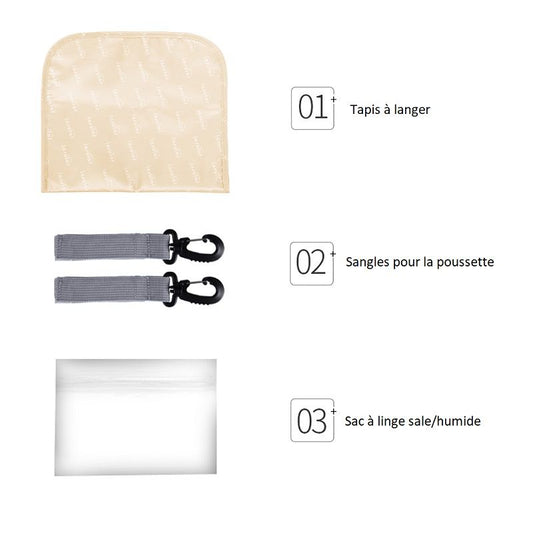You know that old expression: If you give an inch, they'll take a mile? Unfortunately, this adage describes most toddlers well. Little children are constantly pushing boundaries, acting in derogatory ways, and gauging parents' reactions. Children quickly learn what they can do and with whom. It's up to parents to set limits and stick to them as much as possible.
Set limits
When it comes to setting limits, parents often feel uncomfortable upsetting their children. Let’s take the example of learning to sleep. Parents worry that letting a child “cry it out” will make them feel abandoned or unloved. Studies have shown that this is not the case. In fact, setting unambiguous limits is extremely reassuring for children, whether in the area of sleep training or elsewhere. Rather than resenting their parents, children learn to respect them when clear, consistent expectations are reinforced over time.
Discover our Breast pump collection.
Dealing with tantrums
Tantrums are an example of unwanted behavior that responds well to consistent parenting. When toddlers are angry, hungry, or too tired, they often resort to tantrums to express their displeasure. In just five minutes, a cute little angel can transform into a demon from hell. When it comes to handling tantrums, the number one parental rule is to not give in . If a child screams at the top of their lungs and finally gets what they want, then the parent has reinforced the yelling, which (unsurprisingly) will lead to more tantrums.
Strategies at home
At home, a good strategy for handling tantrums is to leave the room and ignore the child. Studies have shown that parents who try to interact with children during tantrums (by holding them or talking to them) may inadvertently make the tantrum worse, further prolonging the joyful experience. In a crisis, don't hesitate to place your little gremlin in his room and close the door (you may need to quietly hold it closed on the other side for a while and tiptoe away once until he has calmed down). As you close the door, you can say something like, "You can come out when you're done yelling." »
Tantrums in public
Tantrums outside the home, in public places, can be more difficult to deal with. When my kids let loose in public, I usually picked them up, placed them in their car seats, and headed home. Leaving a fun place due to bad behavior can be a useful form of negative reinforcement.
Respond to bad behavior
Sometimes bad behavior requires a quick and definitive response. If a child hits, kicks or starts throwing objects at the walls, you will need to give him a severe correction, lest he behave this way towards his teachers and friends at preschool .
Dead time
One strategy parents use to discipline their children is "time out," which can begin as early as one year old. When a small child misbehaves, the parent places him or her in a “naughty corner” for a short time, usually one minute per year of age. Before and after the time-out, the parent explains to the child the reason for the time-out and the child is asked to apologize to the parent.
Isolation in the cradle
Rather than forcing a child to sit in a place where he doesn't poop, I find it much more effective to place him in his crib for some alone time. For children who have not yet learned to climb (and for some who have learned but still respect limits), the crib is a prison. By isolating a child in a crib, you are giving him exactly what he doesn't want: less attention. This helps eliminate unwanted behavior quickly.
Alternative for physical assault
Another strategy for dealing with physical aggression is to provide the child with a socially acceptable way to release negative energy. For example, when my youngest was four years old, she had difficulty reacting physically. Sometimes she would try to hit my husband and me, and other times she would throw things at the wall. To give him a better escape, my husband introduced him to the punching bag in the basement. He taught her some boxing and asked her to punch the bag (or a pillow), instead of punching people, whenever she felt angry. The punching bag strategy, as well as downtime in his room when necessary, went a long way in mitigating this type of behavior.
Confiscate items and use logical consequences
When timeouts don't work, parents may confiscate toys, valuables, or privileges. Whenever possible, they should try to use logical consequences when disciplining a child. For example, a child who breaks the television remote control by throwing it against the wall should lose the right to watch television for a certain period of time. The younger the child, the quicker the consequence should be. Threatening to take away dessert after dinner won't work if it's only nine in the morning. Young children have poor short-term memory and are easily distracted, so punishment should be administered as soon as the unwanted behavior appears.
Use threats and bribes effectively
In some cases, a parent may choose to issue a warning before giving a punishment, especially if the behavior is not too serious (if the behavior is serious, give an immediate consequence and ignore the warning). Here is an example of a warning:
"Amanda, if you don't stop coloring the refrigerator immediately, then I'm going to remove Mr. Muggle (Amanda's beloved stuffed animal)!" »
The key to using threats effectively is carrying them out. If the child does not react positively to the warning, the parent must immediately apply the punishment. Otherwise, the child will not trust the parent and will ignore future threats. Only make threats you can carry out. The same goes for bribes. Don’t hesitate to solicit good behavior by offering bribes. Here is an example:
"Amanda, if you put your blocks away, you can get Mr. Muggle back." »
As with any threat, you must carry out your threat 100%. Be sure to choose your threats and bribes wisely.
Stay calm in the face of bad behavior
One of the common mistakes parents make when faced with bad behavior is to lose their emotional temper. If a child loses their temper, the parent may become upset and start yelling at them. Before you know it, everyone is screaming and the parent has lost control of the situation. Remember, children thrive on attention, including negative attention, so yelling at a young child serves no one. The only thing the child learns is to shout louder than the parent.
Modulate your voice
When children lose their temper, parents should instead modulate their behavior and remain calm. What do I mean by that? If a child begins to scream, parents can get down to their level and speak more softly, in a stern but controlled manner. This not only helps calm the child, but it also gives the parent a sense of control over the situation. By using a calm voice, although still angry, the parent can redirect the child and avoid reinforcing the bad behavior. By seeking higher ground, the parent sets an example for the child. Voice modulation also helps create an emotional wall between parent and child, a valuable strategy in everyone's parenting toolbox.
Avoiding corporal punishment
Children imitate their parents' behavior, so physical punishment is never a good idea. If you don't want your children to have physical contact with you or their friends at school, it's best not to hit them. Hitting a child while telling them it's wrong to do so is ambiguous and confusing. How can a child learn to suppress physical aggression if he is hit or spanked by his parents? On this point, the AAP and I are in complete agreement. Not only is corporal punishment morally wrong, it also teaches children that it is okay to have physical contact when angry, which is the opposite of what most parents would like their children to learn.
Choose your battles
As any parent knows, not every battle is worth fighting. If your child wants to jump in mud puddles or cover their body with stickers (but not tampons), you can choose to allow them to indulge in debauchery and handle the clean-up later. On the other hand, some battles are worth fighting. These include practicing tummy time during infancy (if your baby cries, so be it – tummy time is important for strengthening the neck and preparing for crawling), brushing teeth twice a day (you may need to hold your toddler while brushing), learn to sleep at any age (which is good for you and your child), limit junk food and minimizing screen time, to name a few. When it counts, persevere and don't give up. No matter how stubborn your child is, try to be even more stubborn! And when things don't go as planned, remember that we are all human; despite the best plans, we cannot be rigid all the time.
Positive reinforcement
Finally, if your child behaves well, don't forget to praise him for the good behavior you are trying to achieve. Despite their stupidity, most children want to please their parents and appreciate positive attention. Don't hesitate to congratulate your child, especially when he or she deserves it.
Summary: How Not to Raise a Bully
- Set clear and consistent limits; ideally, all guardians should be on the same page when it comes to establishing and enforcing rules.
- Ignore the tantrums and don't give in.
- Use timeouts, but only if they work; Consider time-outs in the crib or a quiet room if your child continues to run away from the mischief-making area.
- Offer a punching bag (or pillow) to a physically aggressive child.
- Choose threats and bribes wisely and carry them out 100%.
- Practice voice modulation to maintain control when behavior escalates.
- Don't spank or hit your children unless you want to teach them that hitting is okay (be warned: they will eventually hit you back).
- Choose the battles you will fight and don't worry about the details.
- Use lots of positive reinforcement to encourage good behavior.
Last recommendation
Have another baby! Being eclipsed by a new star and learning that you are not the center of the universe is a hard lesson, but it is very good for the soul. For more information and advice on raising children, you can consult the resources on the official National Education website .
























































